Biography of Grinling Gibbons 1648-1721
Grinling Gibbons 1648-1721 is in Sculptors.
On 29 Mar 1641 George Manners 7th Earl of Rutland (age 61) died. His second cousin John Manners 8th Earl of Rutland (age 36) succeeded 8th Earl of Rutland. Frances Montagu Countess Rutland (age 27) by marriage Countess of Rutland. Monument sculpted by Grinling Gibbons at St Mary the Virgin Church, Bottesford, Leicestershire [Map].

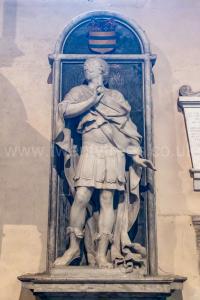
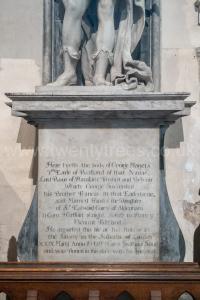
On 04 Apr 1648 Grinling Gibbons was born.
Evelyn's Diary. 18 Jan 1671. Of this young artist (age 22), together with my manner of finding him out, I acquainted the King (age 40), and begged that he would give me leave to bring him and his work to Whitehall Palace [Map], for that I would adventure my reputation with his Majesty (age 40) that he had never seen anything approach it, and that he would be exceedingly pleased, and employ him. The King (age 40) said he would himself go see him. This was the first notice his Majesty (age 40) ever had of Mr. Gibbon (age 22).
Evelyn's Diary. 18 Jan 1671. This day I first acquainted his Majesty (age 40) with that incomparable young man, Gibbon (age 22), whom I had lately met with in an obscure place by mere accident, as I was walking near a poor solitary thatched house, in a field in our parish, near Sayes Court, Deptford [Map]. I found him shut in; but looking in at the window, I perceived him carving that large cartoon, or crucifix, of Tintoretto, a copy of which I had myself brought from Venice, where the original painting remains. I asked if I might enter; he opened the door civilly to me, and I saw him about such a work as for the curiosity of handling, drawing, and studious exactness, I never had before seen in all my travels. I questioned him why he worked in such an obscure and lonesome place; he told me it was that he might apply himself to his profession without interruption, and wondered not a little how I found him out. I asked if he was unwilling to be made known to some great man, for that I believed it might turn to his profit; he answered, he was yet but a beginner, but would not be sorry to sell off that piece; on demanding the price, he said £100. In good earnest, the very frame was worth the money, there being nothing in nature so tender and delicate as the flowers and festoons about it, and yet the work was very strong; in the piece was more than one hundred figures of men, etc. I found he was likewise musical, and very civil, sober, and discreet in his discourse. There was only an old woman in the house. So, desiring leave to visit him sometimes, I went away.
Evelyn's Diary. 19 Feb 1671. This day dined with me Mr. Surveyor, Dr. Christopher Wren (age 47), and Mr. Pepys (age 37), Clerk of the Acts, two extraordinary, ingenious, and knowing persons, and other friends. I carried them to see the piece of carving which I had recommended to the King (age 40). Note. Those of Grinling Gibbons (age 22) - see John Evelyn's Diary 1671 January 18.
Evelyn's Diary. 01 Mar 1671. His Majesty's (age 40) Surveyor, Mr. Wren (age 47), faithfully promised me to employ him. I having also bespoke his Majesty (age 40) for his work at Windsor Castle [Map], which my friend, Mr. May (age 49), the architect there, was going to alter, and repair universally; for, on the next day, I had a fair opportunity of talking to his Majesty (age 40) about it, in the lobby next the Queen's (age 32) side, where I presented him with some sheets of my history. I thence walked with him through St James' Park [Map] to the garden, where I both saw and heard a very familiar discourse between ... and Mrs. Nelly (age 21), as they called an impudent comedian, she looking out of her garden on a terrace at the top of the wall, and ... [Note. the elipsis here is John Evelyn being coy about the King's (age 40) conversation with Nell Gwyn.] standing on the green walk under it. I was heartily sorry at this scene. Thence the King (age 40) walked to the Duchess of Cleveland (age 30), another lady of pleasure, and curse of our nation.


Evelyn's Diary. 01 Mar 1671. I caused Mr. Gibbon (age 22) to bring to Whitehall [Map] his excellent piece of carving, where being come, I advertised his Majesty (age 40), who asked me where it was; I told him in Sir Richard Browne's (age 66) (my father-in-law) chamber, and that if it pleased his Majesty (age 40) to appoint whither it should be brought, being large and though of wood, heavy, I would take care for it. "No", says the King (age 40), "show me the way, I'll go to Sir Richard's (age 66) chamber", which he immediately did, walking along the entries after me; as far as the ewry, till he came up into the room, where I also lay. No sooner was he entered and cast his eyes on the work, but he was astonished at the curiosity of it; and having considered it a long time, and discoursed with Mr. Gibbon (age 22), whom I brought to kiss his hand, he commanded it should be immediately carried to the Queen's (age 32) side to show her. It was carried up into her bedchamber, where she and the King (age 40) looked on and admired it again; the King (age 40), being called away, left us with the Queen (age 32), believing she would have bought it, it being a crucifix; but, when his Majesty (age 40) was gone, a French peddling woman, one Madame de Boord, who used to bring petticoats and fans, and baubles, out of France to the ladies, began to find fault with several things in the work, which she understood no more than an ass, or a monkey, so as in a kind of indignation, I caused the person who brought it to carry it back to the chamber, finding the Queen (age 32) so much governed by an ignorant Frenchwoman, and this incomparable artist had his labor only for his pains, which not a little displeased me; and he was fain to send it down to his cottage again; he not long after sold it for £80, though well worth £100, without the frame, to Sir George Viner (age 32).


Evelyn's Diary. 28 Jun 1678. I went to Windsor [Map] with my Lord Chamberlain (age 60) (the castle now repairing with exceeding cost) to see the rare work of Verrio (age 42), an incomparable carving of Gibbons (age 30).
Evelyn's Diary. 08 Aug 1679. I went this morning to show my Lord Chamberlain (age 61), his Lady (age 45), and the Duchess of Grafton (age 11), the incomparable work of Mr. Gibbon (age 31), the carver, whom I first recommended to his Majesty (age 49), his house being furnished like a cabinet, not only with his own work, but divers excellent paintings of the best hands. Thence, to Sir Stephen Fox's (age 52), where we spent the day.

Evelyn's Diary. 31 Aug 1679. After evening service, to see a neighbor, one Mr. Bohun, related to my son's (age 24) late tutor of that name, a rich Spanish merchant, living in a neat place, which he has adorned with many curiosities, especially several carvings of Mr. Gibbons (age 31), and some pictures by Streeter.
After 29 Sep 1679. Monument to John Manners 8th Earl of Rutland (deceased) and Frances Montagu Countess Rutland. Monument sculpted by Grinling Gibbons (age 31).

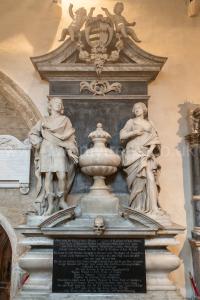
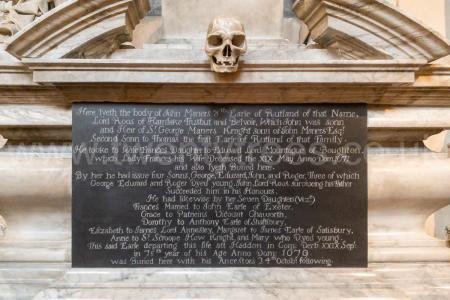
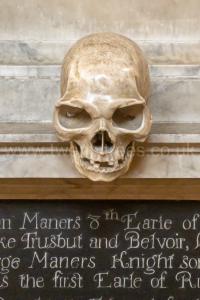
Evelyn's Diary. 24 Jul 1680. Went with my wife (age 45) and daughter to Windsor [Map], to see that stately court, now near finished. There was erected in the court the King (age 50) on horseback, lately cast in copper, and set on a rich pedestal of white marble, the work of Mr. Gibbons (age 32), at the expense of Toby Rustate, a page of the back stairs, who by his wonderful frugality had arrived to a great estate in money, and did many works of charity, as well as this of gratitude to his master, which cost him £1,000. He is very simple, ignorant, but honest and loyal creature.

Evelyn's Diary. 30 Jul 1682. Went to visit our good neighbor, Mr. Bohun, whose whole house is a cabinet of all elegancies, especially Indian; in the hall are contrivances of Japan screens, instead of wainscot; and there is an excellent pendule clock inclosed in the curious flowerwork of Mr. Gibbons (age 34), in the middle of the vestibule. The landscapes of the screens represent the manner of living, and country of the Chinese. But, above all, his lady's cabinet is adorned on the fret, ceiling, and chimney-piece, with Mr. Gibbons's (age 34) best carving. There are also some of Streeter's best paintings, and many rich curiosities of gold and silver as growing in the mines. The gardens are exactly kept, and the whole place very agreeable and well watered. The owners are good neighbors, and Mr. Bohun has also built and endowed a hospital for eight poor people, with a pretty chapel, and every necessary accommodation.
On 29 Oct 1682 Baptist Noel 3rd Viscount Campden (age 71) died. His son Edward Noel 1st Earl Gainsborough (age 41) succeeded 4th Viscount Campden. Elizabeth Wriothesley Countess Gainsborough (age 36) by marriage Viscountess Campden. He was buried at Church of St Peter and St Paul, Exton, Rutlandshire [Map].

A huge monument in black and white marble, with a tall base on which stand obelisks, on balls capped by two black urns and a large open pediment. Within, are the Viscount and his fourth wife Elizabeth Bertie Viscountess Campden (age 42) in effigy and various low reliefs, depicting his previous wives and nineteen children, in Roman dress, completed at least by Grinling Gibbons (age 34).
Elizabeth Bertie Viscountess Campden:
In 1640 she was born to Montagu Bertie 2nd Earl Lindsey and Martha Cockayne Countess Lindsey and Holderness.
On 06 Jul 1655 Baptist Noel 3rd Viscount Campden and she were married. She by marriage Viscountess Campden. The difference in their ages was 29 years. She the daughter of Montagu Bertie 2nd Earl Lindsey and Martha Cockayne Countess Lindsey and Holderness. They were second cousin twice removed.

 In 1683 Elizabeth Bertie Viscountess Campden died.
In 1683 Elizabeth Bertie Viscountess Campden died.
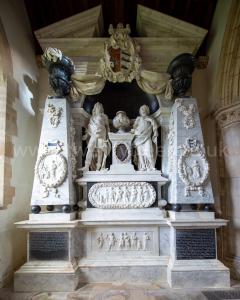
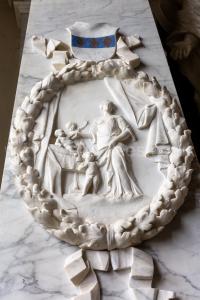
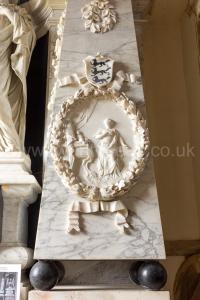
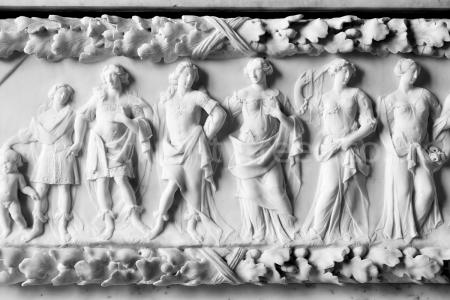
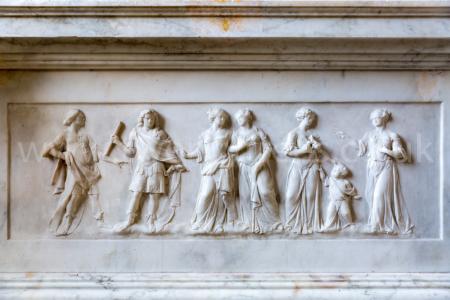
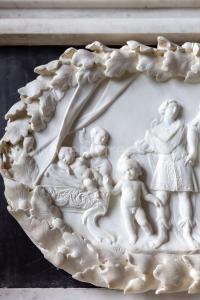
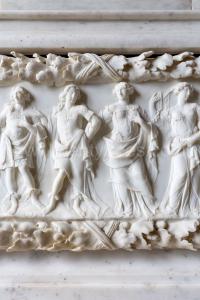
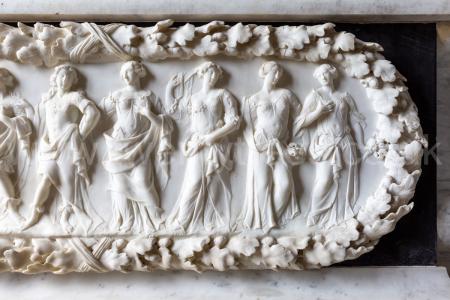
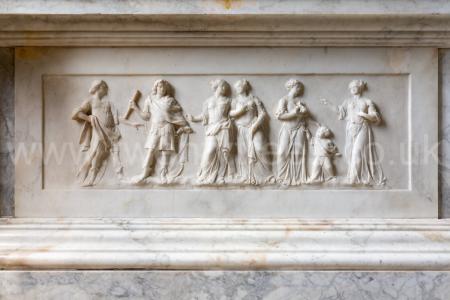
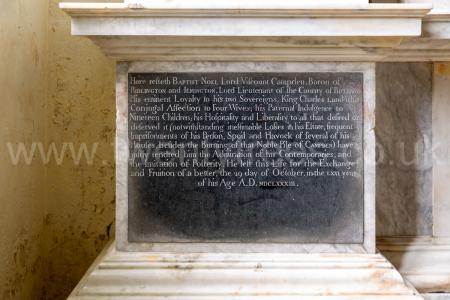
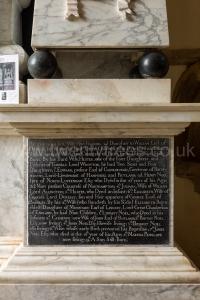
Evelyn's Diary. 16 Jun 1683. That which was new at Windsor [Map] since I was last there, and was surprising to me, was the incomparable fresco painting in St. George's Hall, representing the legend of St. George, and triumph of the Black Prince, and his reception by Edward III.; the volto, or roof, not totally finished; then the Resurrection in the Chapel, where the figure of the Ascension is, in my opinion, comparable to any paintings of the most famous Roman masters; the Last Supper, also over the altar. I liked the contrivance of the unseen organ behind the altar, nor less the stupendous and beyond all description the incomparable carving of our Gibbons (age 35), who is, without controversy, the greatest master both for invention and rareness of work, that the world ever had in any age; nor doubt I at all that he will prove as great a master in the statuary art.
Evelyn's Diary. 07 Dec 1684. I went to see the new church at St. James's, elegantly built; the altar was especialy adorn'd, the white marble inclosure curiously and richly carved, the flowers and garlands about the walls by Mr. Gibbons (age 36) in wood; a pelican with her young at her breast, just over the altar in the carv'd compartment and border, invironing the purple velvet fring'd with I. H. S. richly embroider'd, and most noble plate, were given by Sr R. Geere, to the value (as was said) of £200. There was no altar any where in England, nor has there ben any abroad, more handsomely adorn'd.
Evelyn's Diary. 29 Dec 1686. I went to hear the music of the Italians in the new chapel, now first opened publicly at Whitehall [Map] for the Popish Service. Nothing can be finer than the magnificent marble work and architecture at the end, where are four statues, representing St. John, St. Peter, St. Paul, and the Church, in white marble, the work of Mr. Gibbons (age 38), with all the carving and Pillars of exquisite art and great cost. The altar piece is the Salutation; the volto in fresco, the Assumption of the blessed Virgin, according to their tradition, with our blessed Savior, and a world of figures painted by Verrio. The throne where the King (age 53) and Queen (age 28) sit is very glorious, in a closet above, just opposite to the altar. Here we saw the Bishop in his mitre and rich copes, with six or seven Jesuits and others in rich copes, sumptuously habited, often taking off and Putting on the Bishop's mitre, who sat in a chair with arms pontifically, was adored and censed by three Jesuits in their copes; then he went to the altar and made divers cringes, then censing the images and glorious tabernacle placed on the altar, and now and then changing place: the crosier, which was of silver, was put into his hand with a world of mysterious ceremony, the music playing, with singing. I could not have believed I should ever have seen such things in the King of England's palace, after it had pleased God to enlighten this nation; but our great sin has, for the present, eclipsed the blessing, which I hope he will in mercy and his good time restore to its purity.
Evelyn's Diary. 24 Jan 1687. I saw the Queen's (age 28) new apartment at Whitehall [Map], with her new bed, the embroidery of which cost £3,000. The carving about the chimney piece, by Gibbons (age 38), is incomparable.
After 31 Aug 1687 Monument to Richard Legh (deceased) and Elizabeth Chicheley. Unsigned; possibly sculpted by Grinling Gibbons (age 39). St Oswald's Church, Winwick.
Richard Legh: On 07 May 1634 he was born to Reverend Thomas Legh. On or after 31 Dec 1660 Richard Legh and Elizabeth Chicheley were married. In Mar 1679 Andrew Fountaine was elected MP Newton. His wife's brother-in-law Richard Legh controlled the Newton constituency and paid for his election expenses. On 31 Aug 1687 Richard Legh died.
Elizabeth Chicheley: she was born to Thomas Chicheley of Wimpole and Sarah Russell. In 1728 she died.
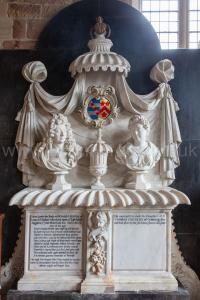
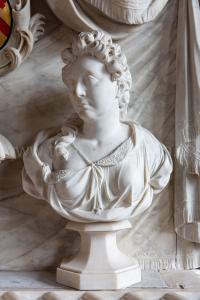
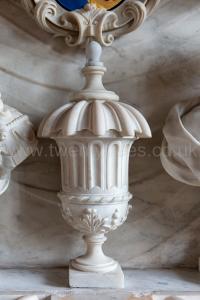
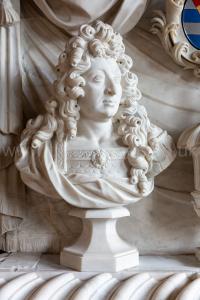
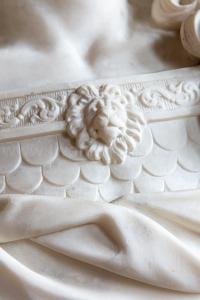
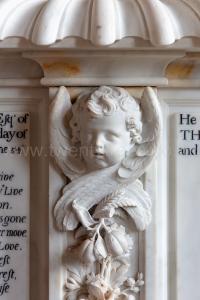
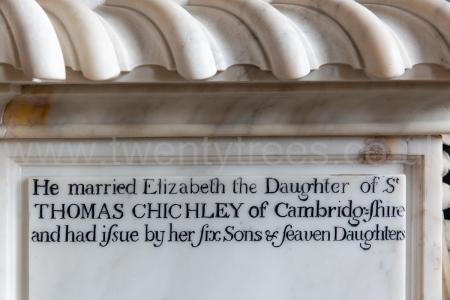
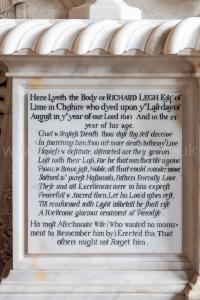
After 1689 Francis Bird (age 22) studied under Grinling Gibbons (age 40).
On 10 Sep 1698 Theophilus Hastings 7th Earl Huntingdon (age 47) wrote to Laurence Cromp of the Herald's Office about his own monument. In the letter he says: "I have now made a perfect agreement, with Mr Gibbons (age 50) the Carver, in Bow Street for the monument which if made according to the modell, I shall like very well; I therefore desire you, to doe me the kindness to Call on him to see in what forwardnesse it is in, and what your judgement is of itt; particularly as to the armes ....". The Earl then talks about the Hastings Crest Bull's Head. The Earl's own monument does not include a Bull's Head so the letter does not appear to be about this. The wall monument does have a Bull's Head as part of the Hastings coat of arms so it could be this monument which the letter is about. However, the wall monument is similar in style to the chest tomb and so would appear to be of the same date. This would leave unresolved the question of why the Earl wrote at such length about the design of the Bull's Head. It also raises the issue of why there are two monuments to the 2nd Earl considering that the family were heavily in debt at the time. (Richard Parker was paid £20, equivalent to £16,600 today, for a similar chest tomb for the 1st Earl of Rutland). Source Church Monuments Society.
On 05 Oct 1698. Theophilus Hastings 7th Earl Huntingdon (age 47) wrote to Grinling Gibbons (age 50): "I desire you to forbear the carving of the arms till you have finished the rest of the monument, and to not go about them till you first aquaint me".
After 30 May 1701. Hasting's Chapel St Helen's Church Ashby-de-la-Zouch, Leicestershire [Map]. Monument to Theophilus Hastings 7th Earl Huntingdon (deceased) sculpted by Grinling Gibbons (age 53).
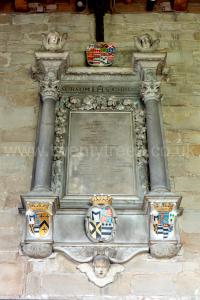
Vesta Monumenta. Plate 1.3: Engraving of the Baptismal Font at St. James's, Piccadilly.
Plate 1.3 of Vetusta Monumenta depicts a marble baptismal font at St. James's Church, Piccadilly, presumed to be carved by Grinling Gibbons (age 69) in 1685. Engraving by George Vertue (age 34) after Charles Woodfield. 457 x 283 mm. Published by the Society of Antiquaries of London in 1718. Current location: St. James's Church, Piccadilly, London, UK.
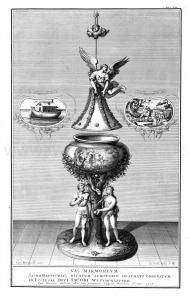
On 03 Aug 1721 Grinling Gibbons (age 73) died.
Letters of Horace Walpole. 05 Aug 1752. Here our woes increase. The roads row bad beyond all badness, the night dark beyond all darkness, our guide frightened beyond all frightfulness. However, without being at all killed, we got UP, or down,-I forget which, it was so dark,-a famous precipice called Silver Hill, and about ten at night arrived at a wretched village called Rotherbridge. We had still six miles hither, but determined to stop, as it would be a pity to break our necks before we had seen all we intended. But alas! there was only one bed to be had: all the rest were inhabited by smugglers, whom the people of the house called mountebanks; and with one of whom the lady of the den told Mr. Chute he might lie. We did not at all take to this society, but, armed with links and lanthems, set out again upon this impracticable journey. At two o'clock in the morning we got hither to a still worse inn, and that crammed with excise officers, one of whom had just shot a smuggler. However, as we were neutral powers, we have passed safely through both armies hitherto, and can give you a little farther history of our wandering through these mountains, where the young gentlemen are forced to drive their curricles with a pair of oxen. the only morsel of good road we have found, was what even the natives had assured us was totally impracticable: these were eight miles to Hurst Monceaux.338 It is seated at the end of a large vale, five miles in a direct line to the sea, with wings of blue hills covered with wood, one of which falls down to the in a sweep of a hundred acres. The building, for the convenience of water to the moat, sees nothing at all; indeed it is entirely imagined on a plan of defence, with drawbridges actually in being, round towers, watch-towers mounted on them, and battlements pierced for the passage of arrows from long bows. It was built in the time of Henry VI, and is as perfect as the first day. It does not seem to have been ever quite finished, or at least that age was not arrived at the luxury of white-wash; for almost all the walls, except in the principal chambers, are in their native brickhood. It is a square building, each side about two hundred feet in length; a porch and cloister, very like Eton College; and the whole is much in the same taste, the kitchen extremely so, with three vast funnels to the chimneys going up on the inside. There are two or three little courts for offices, but no magnificence of apartments. It is scarcely furnished with a few necessary beds and chairs: one side has been sashed, and a drawing-room and dining-room and two or three rooms wainscoted by the Earl of Sussex, who married a natural daughter of Charles II. Their arms with delightful carvings by Gibbons-, particularly two pheasants, hang over the chimneys. Over the great drawing-room chimney is the first coat armour of the first Leonard, Lord Dacre, with all his alliances. Mr. Chute was transported, and called cousin with ten thousand quarterings.339 The chapel is small, and mean: the Virgin and seven long lean saints, ill done, remain in the windows. There have been four more, but seem to have been removed for light; and we actually found St. Catherine, and another gentlewoman with a church in her hand, exiled into the buttery. There remain two odd cavities, with very small wooden screens on each side the altar, which seem to have been confessionals. The outside is a mixture of gray brick and stone, that has a very venerable appearance. The drawbridges are romantic to a degree; and there is a dungeon, that gives one a delightful idea of living in the days of soccage and under such goodly tenures. They showed us a dismal chamber which they called Drummer's-hall, and suppose that Mr. Addison's comedy is descended from it. In the windows of the gallery over the cloisters, which leads all round to the apartments, is the device of the Fienneses, a wolf holding a baton with a scroll, Le roy le veut - an unlucky motto, as I shall tell you presently, to the last peer of that line. The estate is two thousand a year, and so compact as to have but seventeen houses upon it. We walked up a brave old avenue to the church, with ships sailing on our left hand the whole way. Before the altar lies a lank brass knight, knight William Fienis, chevalier, who obiit c.c.c.c.v. that is in 1405. By the altar is a beautiful tomb, all in our trefoil taste, varied into a thousand little canopies and patterns, and two knights reposing on their backs. These were Thomas, Lord Dacre, and his only son Gregory, who died sans issue. An old grayheaded beadsman of the family talked to us of a blot in the scutcheon; and we had observed that the field of the arms was green instead of blue, and the lions ramping to the right, contrary to order. This and the man's imperfect narrative let us into the circumstances of the personage before us; for there is no inscription. He went in a Chevy-chase style to hunt in a Mr. Pelham's (age 57)340 park at Lawton: the keepers opposed, a fray ensued, a man was killed. The haughty baron took the death upon himself, as most secure of pardon; but however, though there was no chancellor of the exchequer in the question, he was condemned to be hanged: Le roy le Vouloist.

Note 338. the ancient inheritance of Lord Dacre of the South.-E.
Note 339. Chaloner Chute, Esq, of the Vine, married Catherine, daughter of Richard, Lord Dacre.-E.
Note 340. At the date of this letter Mr. Pelham (age 57) was prime minister.